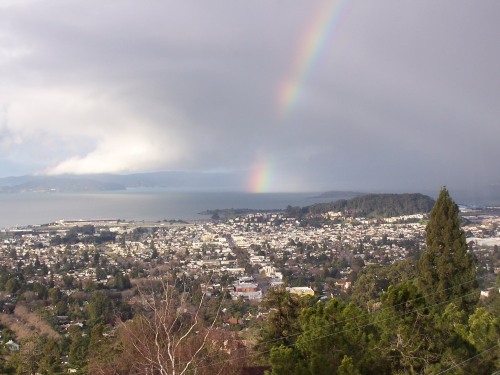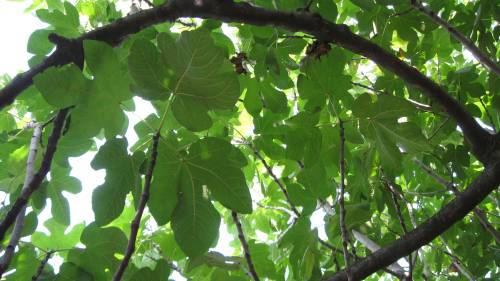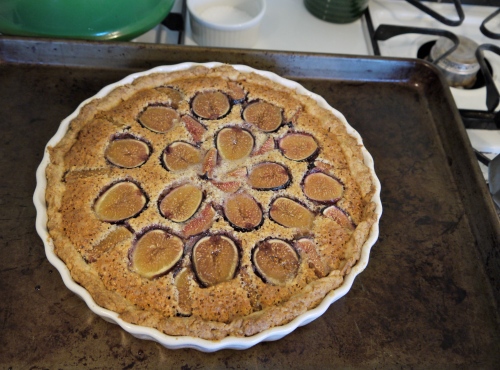Figs will always be associated with some of the happiest times in my life, and with the geographical locations of this happiness. I think of the black mission figs rolling down the steep sidewalks of the Berkeley hills, too plentiful to collect before the early autumn sun softened them too much. Homeowners guarded their Meyer lemons fiercely up there, but the fig trees, with their too-high boughs too heavily laden, invited urban foragers to find a perfect fallen fruit.
As a grad student and a poetry lecturer, we were ridiculously lucky in the location of our home: the top floor of a run-down building on a prominent curve of Euclid Avenue. Our front windows looked out over the San Francisco Bay. We became aesthetically immune to spectacular sunsets and the beauty of the Golden Gate Bridge on a sunny morning. This storm caught our attention, though.

This was where we lived when Jack was born, and I used to walk with him in the Baby Bjorn or Ergo all around the hills, picking up a fig here and there. I’ve been thinking about this time a lot lately because I’m trying to remember what it’s like to have a baby. Our second one will arrive in about two weeks…
Was my big boy ever this small?
The other happy fig-associated time in a Mediterranean climate that I think about is of course our year in Rome. How many fresh figs drizzled with honey did I eat? Mmmm… too many to count.
Cool shade of the fig canopy:

The other day I bought a tray of California figs at Trader Joe’s, knowing full well that they’d turn to mush in a few days. But I wanted them! And this weekend we have the perfect excuse for me to go through a pile of figs: a dinner party for which I volunteered to bring dessert. Ever since I tried the fig tart at Patisserie 46, I’ve been wanting to recreate it. I’m fairly sure the figs were nestled in frangipane—that transcendent almond filling—so I looked in all of my cookbooks for a fig or fig frangipane tart recipe, but didn’t find one. (I could have looked online, but my cookbooks have been suffering neglect.) I did find, in a Williams-Sonoma Pie & Tart cookbook that my sister gave me for Christmas one year a recipe for a pear and frangipane tart. I decided to use this one, modifying for figs, and substituting my favorite crust recipe, from Nancy Silverton’s Pastries from La Brea Bakery.
Sweet Pastry Dough
2 3/4 c. unbleached pastry flour or unbleached all-purpose flour
1/2 c. granulated sugar
2 sticks unsalted butter, cut into half-inch cubes
2 extra-large egg yolks
1/4 c. heavy creamIn the bowl of a food processor fitted with the steel blade or in the bowl of an electric mixer fitted with the paddle attachment, combine the flour and sugar and pulse or mix on low to incorporate. Add the butter, and pulse on and off or mix on low until it’s the consistency of a fine meal.
In a small bowl, whisk together the egg yolks and cream. Add to the butter mixture and pulse a few times or mix on low until the dough barely comes together.
Turn the dough out onto a lightly floured work surface. Dip the heel of your hand in flour and, working with small sections, smear the dough away from you to blend it together. When the dough has been all smeared out, using a metal scraper or spatula, scrape and gather it together. Divide the dough in half and gently knead each half to gather into a ball. Flatten into discs and wrap in plastic to chill at least 2 hours, until firm. Freeze for longer storage.
Since this tart calls only for a bottom crust, I used the other half of the dough to make sugar cookies in the shapes of pumpkins and ghosts. Jack will help me decorate them later.
Fig and Frangipane Tart (based on Pear and Frangipane Tart in Williams-Sonoma’s Pie & Tart book)
Filling:
2 tbs. unsalted butter, melted
1 1/2 c. raw, whole almonds, finely ground
2/3 c. sugar
2 large eggs, lightly beaten
1/2 tsp. almond extract
1 tsp. vanilla extract
2 tbs. rum (or lemonade)
1/4 tsp. salt
1 tsp. finely grated lemon zest
10-12 ripe figs
honey
Preheat oven to 375 degrees.
When butter has cooled, mix it with the almonds, sugar, eggs, extracts, rum, salt, and zest. Spread mixture evenly in the tart shell. Slice each fig in half and arrange in the tart
Bake until the filling is firm to the touch in the center and golden, about 45 minutes. Drizzle with honey. Transfer to a wire rack to cool.



























 Italy’s Parliament
Italy’s Parliament 









